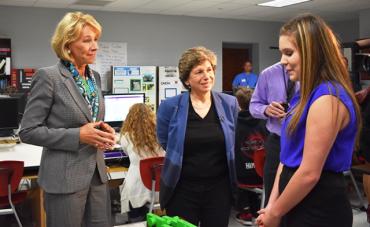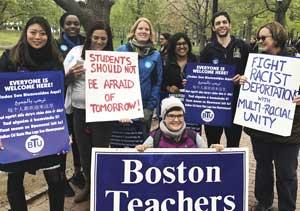VISIT SHOWS PROMISE OF PUBLIC EDUCATION
Van Wert, Ohio, earned high marks for its public schools when AFT President Randi Weingarten and Education Secretary Betsy DeVos, shown below, toured the district this spring with major media outlets. News coverage of the April 20 visit focused not on partisan rancor but on robust, well-supported public school approaches from prekindergarten through high school. It was a chance for one small Midwest school district in a Republican-leaning community to showcase the great work going on inside its public schools—proof positive that “support for public schools transcends politics,” Weingarten told reporters at a wrap-up press conference.
A CRUEL, CATASTROPHIC BUDGET
President Trump and Education Secretary Betsy DeVos have proposed a $10.6 billion cut in federal education funding in the next fiscal year, after factoring in more than $1 billion for vouchers and other school choice options. The White House budget, announced in late May, would eliminate more than 20 programs, including after-school programs that serve 1.6 million children, and $2.1 billion for teacher training and class size reduction. It would cut more than $700 million from Perkins loans for higher education and $168 million for career and technical education. Much of this funding would be shifted to school choice. Trump and DeVos are seeking $400 million to expand charter schools and vouchers for private and religious schools. Another $1 billion would be diverted into new grants that pressure public schools to adopt school choice policies through federal incentives that are modeled after the now-defunct Race to the Top program. The White House also would move $250 million into new grants for voucher research and expansion.
AFT President Randi Weingarten called the plan “cruel, catastrophic,” and at odds with the investments made by Congress just a few weeks before the budget’s release. In early May, Congress approved a spending bill for the current fiscal year that invests in “public education, healthcare, and programs that help working families and particularly their children,” Weingarten said. “It stands in stark contrast to Trump and DeVos’s efforts to defund public education by reaching consensus across party lines to invest in public schools, [and] Congress should follow this blueprint to invest in public schools in the 2018 budget as well.” For more on Trump’s proposed education cuts, visit The Atlantic.
CUTS TO MEDICAID AND EDUCATION SERVICES
The American Health Care Act won a narrow, party-line victory in the U.S. House of Representatives on May 4, and there are growing concerns that this bill would hit the classroom hard should it become law. The House-passed bill, for example, would cut Medicaid by 25 percent over 10 years and impose a “per-capita cap” on funding for certain groups of people, such as children and the elderly. That is a major concern for schools, since Medicaid helps schools offset costs for special education services and equipment, and for some preventive care for other Medicaid-eligible students. A coalition of education and advocacy groups warns that these cuts would force states to “ration health care for children,” the New York Times reports.
MORE THAN A PLAYGROUND FIGHT
The U.S. Supreme Court in April heard arguments in Trinity Lutheran Church of Columbia v. Comer, which could become a major church-state decision by the court. It centers on a 2012 application by a Missouri church for a state grant to help fix the church’s preschool playground. Missouri originally declined the application based on a state constitutional provision prohibiting direct or indirect public funding to religious organizations. “This is the first case the court has heard in a decade and a half about providing resources to churches,” observes The Atlantic magazine, and it could “shape future fights over school-voucher programs.” For details, visit SCOTUSblog.
MOBILIZATION TO BUILD SCHOOLS, NOT WALLS
“Build schools, not walls” was the message delivered by AFT activists at a series of May 1 rallies, marches, and meetings held in hundreds of cities around the nation. Participants joined with immigrant communities, students, parents, and engaged citizens to support public education and to fight for a fairer and more just immigration system. Demonstrations, like the one in Boston shown below, underscored the need to keep schools as safe spaces, free from immigration raids, bigotry, and hate. Protesters also demanded that funds meant for a border wall be used instead to strengthen public schools. It was the latest in a series of national mobilizations coordinated by the AFT, the Alliance to Reclaim Our Schools, and the National Education Association.


